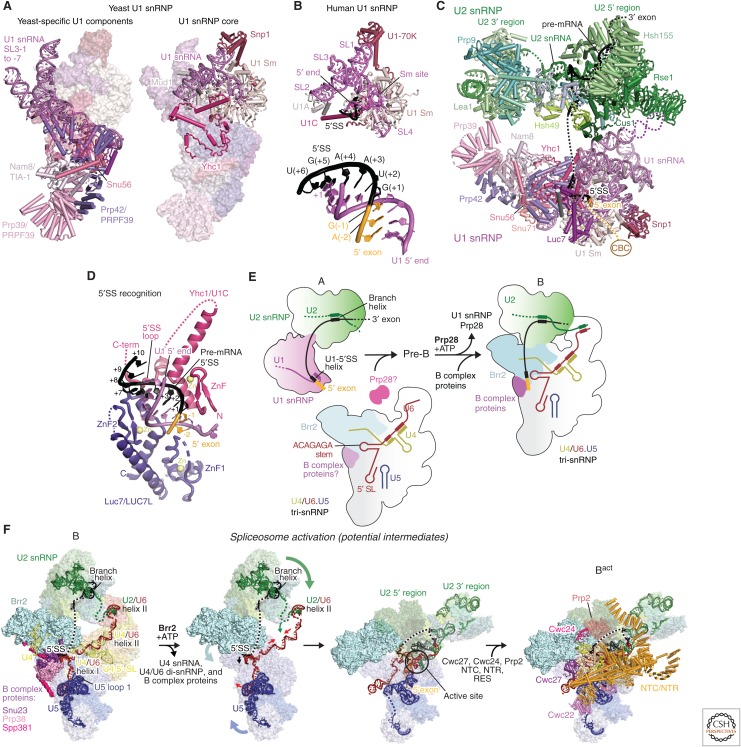Figure 3.
Spliceosome assembly and activation. (A) The yeast U1 small nuclear ribonucleoprotein particle (snRNP) structure (PDB 5UZ5) contains the conserved core of the U1 snRNP (right) and additionally contains yeast-specific RNA elements and eight proteins (left). (B) 5′ splice site (5′SS) recognition by the U1 small nuclear RNA (snRNA) 5′ end in the human minimal U1 snRNP crystal structure (PDB 4PJO). (C) Yeast A complex assembled on UBC4 precursor messenger RNA (pre-mRNA) (PDB 6G90). (D) The RNA duplex formed between the 5′SS and the 5′ end of U1 snRNA interacts with Yhc1(U1C) and Luc7 in yeast A complex. The 5′ end of U1 snRNA and Luc7, completely disordered in the free U1 snRNP (Li et al. 2017), become ordered when pre-mRNA 5′SS binds to U1 snRNP to form the A complex (Plaschka et al. 2018). (E) Schematic model of early assembly events of the spliceosome. The A complex associates with the U4/U6.U5 tri-snRNP to form the pre-B complex, which is subsequently converted by Prp28 activity into the B complex spliceosome. For more details, see Plaschka et al. (2018). (F) Model for spliceosome activation, the B to Bact complex transition. Possible steps during activation are shown, starting with the cryo-electron microscopy (cryo-EM) structure of the yeast B complex (PDB 5NRL) and ending with the Bact complex (PDB 5GM6). During spliceosome activation, U4 snRNA and at least 22 proteins dissociate, 24 proteins join, and the RNA-based active site containing two catalytic magnesium ions forms. First, the Brr2 helicase unwinds the U4/U6 snRNA duplex to initiate the release of U4 snRNA and U4/U6 di-snRNP-specific, tri-snRNP-specific, and B complex proteins. After U4 snRNA dissociation, U6 snRNA folds to form the internal stem loop (ISL) and associates with part of U2 snRNA to form the catalytic RNA core. The nineteen complex (NTC) and nineteen-related (NTR) proteins and the Bact-specific proteins join to cradle the active site RNA core, which remains largely unchanged during the branching and exon-ligation reactions.

